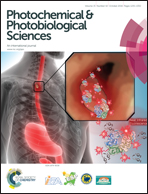Enhanced photocatalytic degradation of phenol over anatase TiO2 in neutral water on addition of iron(iii) substituted polyoxotungstate
Abstract
PW12O40-type polyoxometalates have been widely used as electron mediators of TiO2 photocatalysis for organic degradation in water, but they are stable only at pH 1–2, which greatly limits their application for water treatment. Herein we report an iron(III)-substituted PW11O39 (PW11Fe) capable of mediating the photocatalytic degradation of phenol and 2,4-dichlorophenol in an aerated aqueous suspension of anatase TiO2 at pH 2.0–7.2. As the initial concentration of PW11Fe or the initial pH of the suspension increased, the rate of phenol degradation increased, and then decreased. A maximum reaction rate was achieved at 2.0 mM PW11Fe and pH 5.5, which was 3.9 times higher than that measured without PW11Fe. In all cases, the rates of phenol degradation were of the first order in phenol, implying the recycling behavior of PW11Fe. Through electrochemical measurement, a possible mechanism is proposed, which involves the interfacial electron transfer from the irradiated TiO2 to PW11Fe, and the reduction of O2 by the reduced PW11Fe. This would improve the efficiency of the charge separation of TiO2, and consequently increase the rate of phenol degradation at interfaces.


 Please wait while we load your content...
Please wait while we load your content...